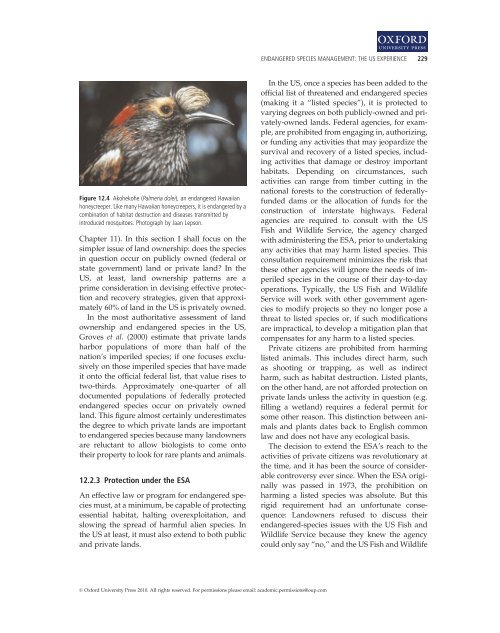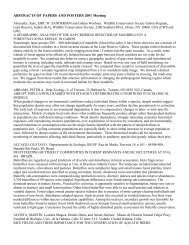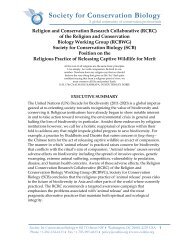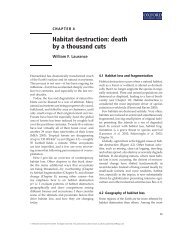Endangered species management: the US experience - Society for ...
Endangered species management: the US experience - Society for ...
Endangered species management: the US experience - Society for ...
Create successful ePaper yourself
Turn your PDF publications into a flip-book with our unique Google optimized e-Paper software.
1<br />
ENDANGERED SPECIES MANAGEMENT: THE <strong>US</strong> EXPERIENCE 229<br />
Figure 12.4 Akohekohe (Palmeria dolei), an endangered Hawaiian<br />
honeycreeper. Like many Hawaiian honeycreepers, it is endangered by a<br />
combination of habitat destruction and diseases transmitted by<br />
introduced mosquitoes. Photograph by Jaan Lepson.<br />
Chapter 11). In this section I shall focus on <strong>the</strong><br />
simpler issue of land ownership: does <strong>the</strong> <strong>species</strong><br />
in question occur on publicly owned (federal or<br />
state government) land or private land In <strong>the</strong><br />
<strong>US</strong>, at least, land ownership patterns are a<br />
prime consideration in devising effective protection<br />
and recovery strategies, given that approximately<br />
60% of land in <strong>the</strong> <strong>US</strong> is privately owned.<br />
In <strong>the</strong> most authoritative assessment of land<br />
ownership and endangered <strong>species</strong> in <strong>the</strong> <strong>US</strong>,<br />
Groves et al. (2000) estimate that private lands<br />
harbor populations of more than half of <strong>the</strong><br />
nation’s imperiled <strong>species</strong>; if one focuses exclusively<br />
on those imperiled <strong>species</strong> that have made<br />
it onto <strong>the</strong> official federal list, that value rises to<br />
two-thirds. Approximately one-quarter of all<br />
documented populations of federally protected<br />
endangered <strong>species</strong> occur on privately owned<br />
land. This figure almost certainly underestimates<br />
<strong>the</strong> degree to which private lands are important<br />
to endangered <strong>species</strong> because many landowners<br />
are reluctant to allow biologists to come onto<br />
<strong>the</strong>ir property to look <strong>for</strong> rare plants and animals.<br />
12.2.3 Protection under <strong>the</strong> ESA<br />
An effective law or program <strong>for</strong> endangered <strong>species</strong><br />
must, at a minimum, be capable of protecting<br />
essential habitat, halting overexploitation, and<br />
slowing <strong>the</strong> spread of harmful alien <strong>species</strong>. In<br />
<strong>the</strong> <strong>US</strong> at least, it must also extend to both public<br />
and private lands.<br />
In <strong>the</strong> <strong>US</strong>, once a <strong>species</strong> has been added to <strong>the</strong><br />
official list of threatened and endangered <strong>species</strong><br />
(making it a “listed <strong>species</strong>”), it is protected to<br />
varying degrees on both publicly-owned and privately-owned<br />
lands. Federal agencies, <strong>for</strong> example,<br />
are prohibited from engaging in, authorizing,<br />
or funding any activities that may jeopardize <strong>the</strong><br />
survival and recovery of a listed <strong>species</strong>, including<br />
activities that damage or destroy important<br />
habitats. Depending on circumstances, such<br />
activities can range from timber cutting in <strong>the</strong><br />
national <strong>for</strong>ests to <strong>the</strong> construction of federallyfunded<br />
dams or <strong>the</strong> allocation of funds <strong>for</strong> <strong>the</strong><br />
construction of interstate highways. Federal<br />
agencies are required to consult with <strong>the</strong> <strong>US</strong><br />
Fish and Wildlife Service, <strong>the</strong> agency charged<br />
with administering <strong>the</strong> ESA, prior to undertaking<br />
any activities that may harm listed <strong>species</strong>. This<br />
consultation requirement minimizes <strong>the</strong> risk that<br />
<strong>the</strong>se o<strong>the</strong>r agencies will ignore <strong>the</strong> needs of imperiled<br />
<strong>species</strong> in <strong>the</strong> course of <strong>the</strong>ir day-to-day<br />
operations. Typically, <strong>the</strong> <strong>US</strong> Fish and Wildlife<br />
Service will work with o<strong>the</strong>r government agencies<br />
to modify projects so <strong>the</strong>y no longer pose a<br />
threat to listed <strong>species</strong> or, if such modifications<br />
are impractical, to develop a mitigation plan that<br />
compensates <strong>for</strong> any harm to a listed <strong>species</strong>.<br />
Private citizens are prohibited from harming<br />
listed animals. This includes direct harm, such<br />
as shooting or trapping, as well as indirect<br />
harm, such as habitat destruction. Listed plants,<br />
on <strong>the</strong> o<strong>the</strong>r hand, are not af<strong>for</strong>ded protection on<br />
private lands unless <strong>the</strong> activity in question (e.g.<br />
filling a wetland) requires a federal permit <strong>for</strong><br />
some o<strong>the</strong>r reason. This distinction between animals<br />
and plants dates back to English common<br />
law and does not have any ecological basis.<br />
The decision to extend <strong>the</strong> ESA’s reach to <strong>the</strong><br />
activities of private citizens was revolutionary at<br />
<strong>the</strong> time, and it has been <strong>the</strong> source of considerable<br />
controversy ever since. When <strong>the</strong> ESA originally<br />
was passed in 1973, <strong>the</strong> prohibition on<br />
harming a listed <strong>species</strong> was absolute. But this<br />
rigid requirement had an un<strong>for</strong>tunate consequence:<br />
Landowners refused to discuss <strong>the</strong>ir<br />
endangered-<strong>species</strong> issues with <strong>the</strong> <strong>US</strong> Fish and<br />
Wildlife Service because <strong>the</strong>y knew <strong>the</strong> agency<br />
could only say “no,” and <strong>the</strong> <strong>US</strong> Fish and Wildlife<br />
© Ox<strong>for</strong>d University Press 2010. All rights reserved. For permissions please email: academic.permissions@oup.com






